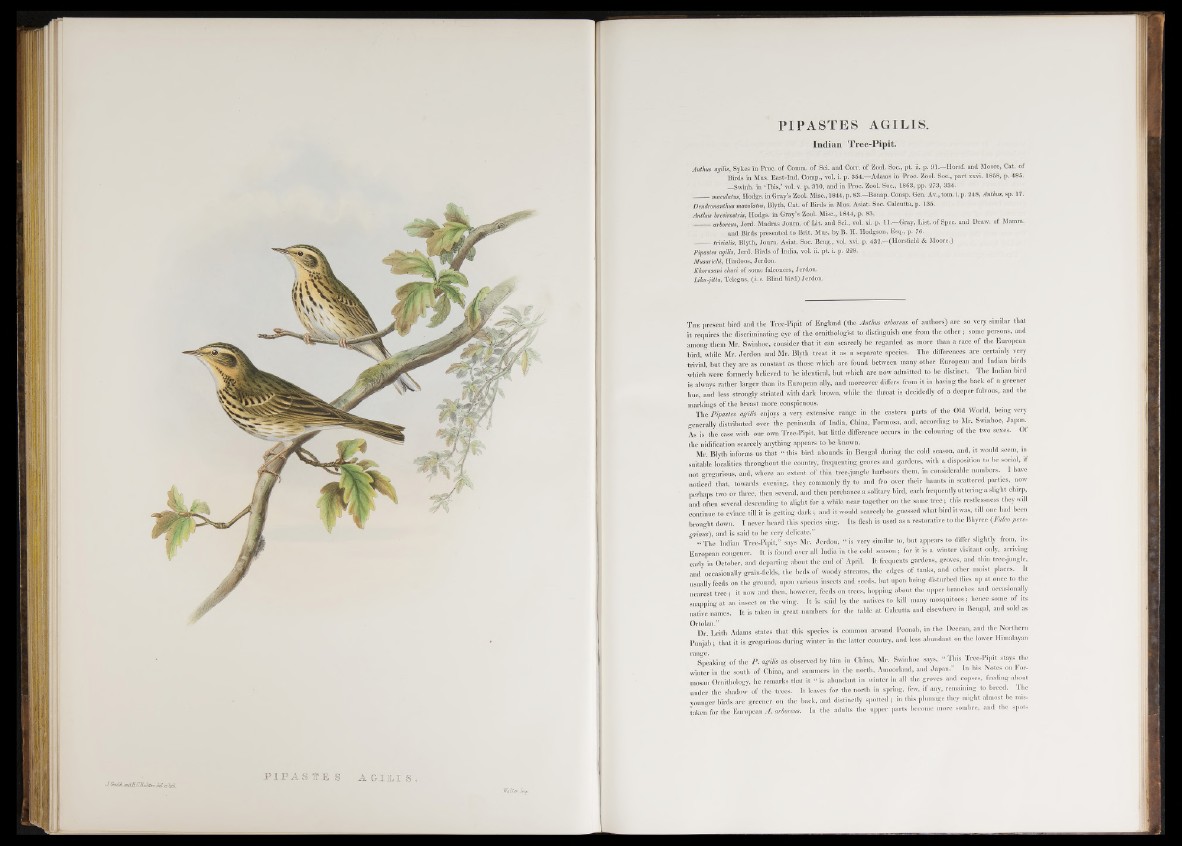
PIPASTES AGILIS.
Indian Tree-Pipit.
Anthus agilis, Sykes in Proc. of Comm, of Sci. and Corr. of Zook Sb'c., pt. ii. p. 91.—Horsf. and Moots, Cat. of
Birds in Mus. East-Ind. Comp., vol. i. p. 354— Adams in Proc. Zool. Soc., part xxvi. 1858, p. 485.
—Swinh. in ‘ Ibis,’ Vol. v. p. 310, and in Proc. Zo6'l. Soc., 1863, pp. 273, 334.
rnaculatus, Hodgs. in Gray’s Zool. Misc., 1844, p. 83 —Bonap. Consp. Gen. Av., tom. i. p. 248, Anthus, sp. 17.
Dendronanthus rnaculatus, Blyth, Cat. of Birds in Mus. Asiat. Soc. Calcutta, p. 136.
Anthus brevirostris, Hodgs. in Gray’s Zool. Misc.* 1844, p. 83.
arboreus, Jerd. Madras Journ. of Lit. and Sci., vol. xi. p. 11.—Gray, List, of Spec, and Draw, of Mamm.
and Birds presented to Brit. Mus. byB. H. Hodgson, Esq., p. 76.
trivialis, Blyth, Journ. Asiat. Soc. Bemg., vol. xvi. p. 432,—(Horsfield & Moore.)
Pipastes agilis, Jerd. Birds of India, vol. ii. pt. i. p. 228.
Musarichi, Hindoos, Jerdon.
Khorasani churi of some falconers, Jerdon.
Liku-jitta, Telegus, (i. e. Blind bird) Jerdon.
T h e present bird and the Tree-Pipit of England (the Anthus arboreus of authors) are so very similar that
it requires the discriminating eye of the ornithologist to distinguish one from the o th e r ; some persons, and
among them Mr. Swinhoe, consider that it can scarcely be regarded as more than a race of the European
bird, while Mr. Jerdon and Mr. Blyth treat it as a separate species. The differences are certainly very
trivial, but they are as constant as those which are found between many other European and Indian birds
which were formerly believed to be identical, but which are now admitted to be distinct. The Indian bird
is always rather larger than its European ally, and moreover differs from it in having the back of a greener
hue, and less strongly striated with dark brown, while the throat is decidedly of a deeper fulvous, and the
markings of the breast more conspicuous..
The Pipastes agilis enjoys a very extensive range in the eastern parts of the Old World, being very
generally distributed over the peninsula of India, China, Formosa, and, according to Mr. Swinhoe, Japan.
As is the case with our own Tree-Pipit, but little difference occurs in the colouring of the two sexes. Of
the nidification scarcely anything appears to.be known.
Mr. Blyth informs us that “ this bird abounds in Bengal during the cold season, and, it would seem, in
suitable localities throughout the country, frequenting groves and gardens, with a disposition to be social, if
not gregarious, and, where an extent of thin tree-jungle harbours them, in considerable numbers. I have
noticed that, towards evening, they commonly fly to and fro over their haunts in scattered parties, now
perhaps two or three, then several, and theu perchance a solitary bird, each frequently uttering a slight chirp,
and often several descending to alight for a while near together on the same t r e e ; this restlessness they will
continue to evince till it is getting d a rk ; and it would scarcely be guessed what bird it was, till one had been
brought down. I never heard this species sing. Its flesh is used as a restorative to the Bllyree iF a ko pere-
grinas), and is said to be very delicate.”
“ T he Indian Tree-Pipit,” says Mr. Jerdon, ‘«is very similar to, but appears to differ slightly from, its
European congener. I t is found over all India in the cold season; for it is a winter visitant only, arriving
early in October, and departing about the end of April. It frequents gardens, groves, and thin tree-jungle,
and occasionally grain-fields, the beds of woody streams, the edges of tanks, and other moist places. It
usually feeds on the ground, upon various, insects and seeds, but upon being disturbed flies up at once to: the
nearest tre e ; it now and then, however, feeds on trees, hopping about the upper branches and occasionally
snapping at an insect on the wing. I t is said by the natives to kill many mosquitoes; hence some of its
native names. It is taken in great numbers for the table at Calcutta and elsewhere in Bengal, and sold as
Ortolan.” , , xT .1
Dr. Leith Adams states that this species is common around Poonah, m the Deccan, and the Northern
Punjab; that it is gregarious: during winter in the latter country, and less abundant on the lower Himalayan
range. n . . , .
Speaking of the P . agilis as observed by him in China, Mr. Swinhoe says, “ This Tree-Pipit stays the
winter in the south of China, and summers in the north, Amoorland, and Japan." In his Notes on Formosan
Ornithology, he remarks that it “ is abundant in winter in all tile groves and copses, feeding about
under the shadow of the trees. It leaves for the north in spring, few, if any, remaining to breed. The
younger birds are greener on the back, and distinctly ¡spotted I in this plumage they might almost be mistaken
for the European A . arboreus. In the adults the upper parts become more sombre, and the spots